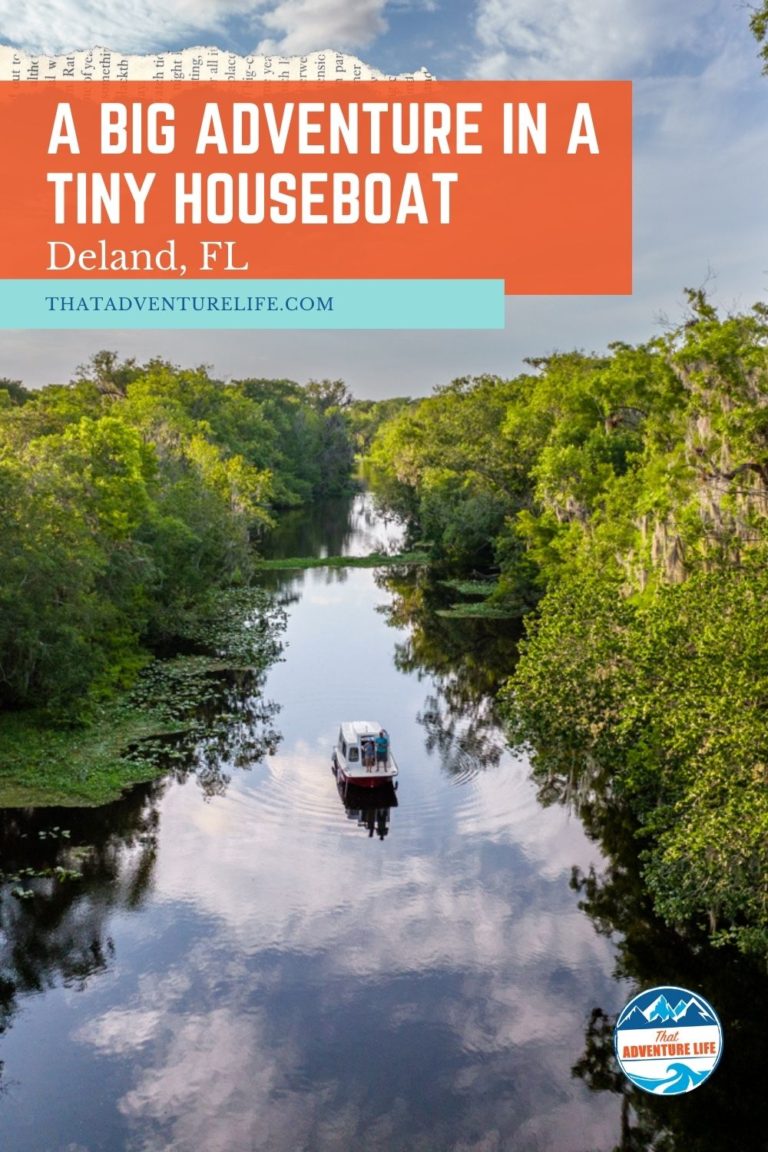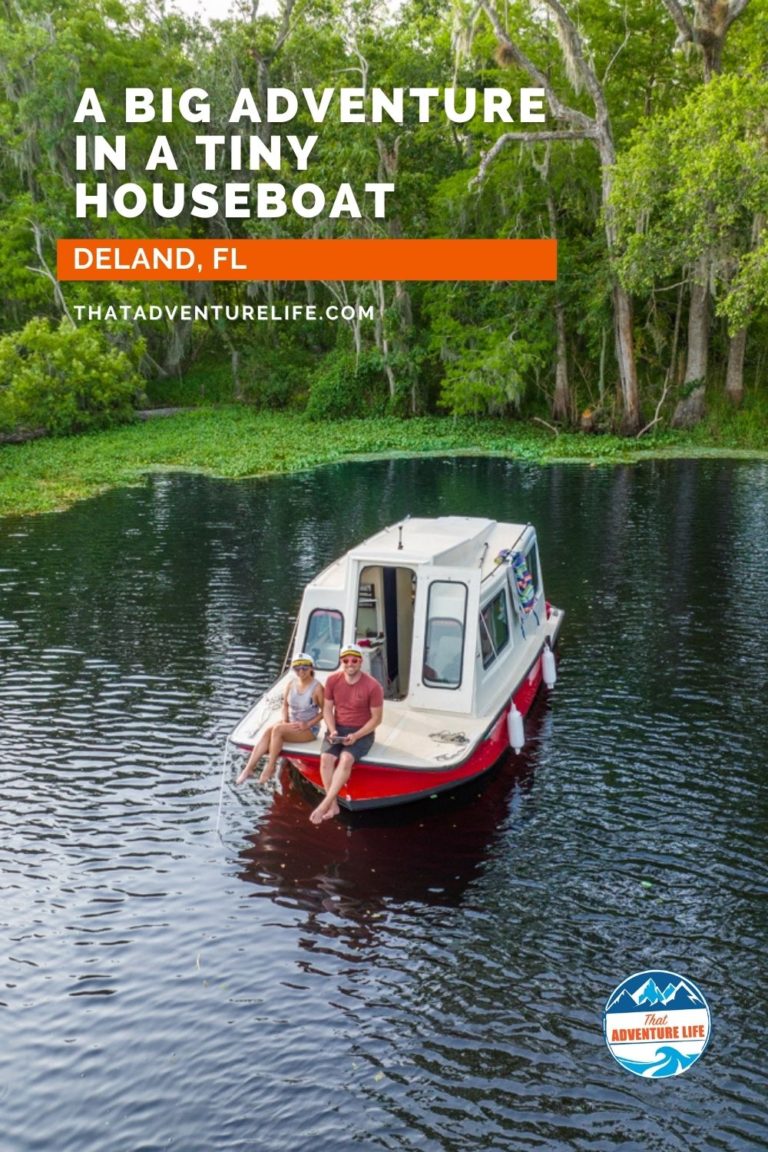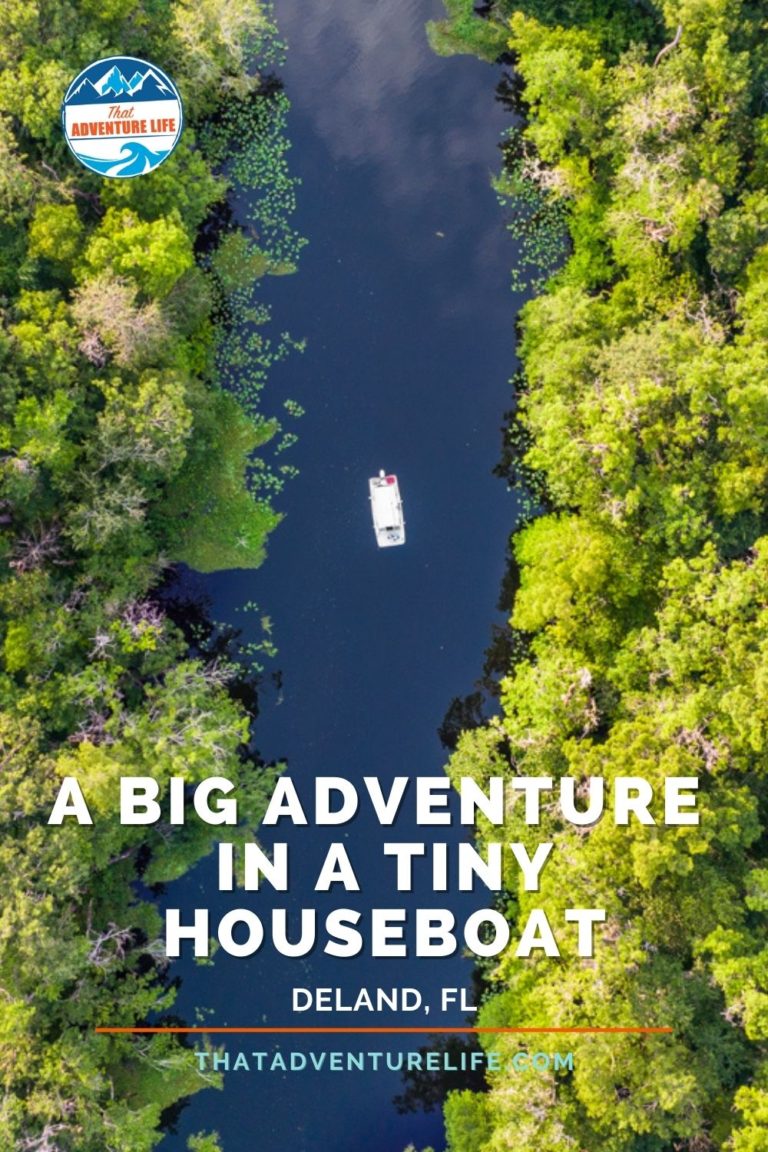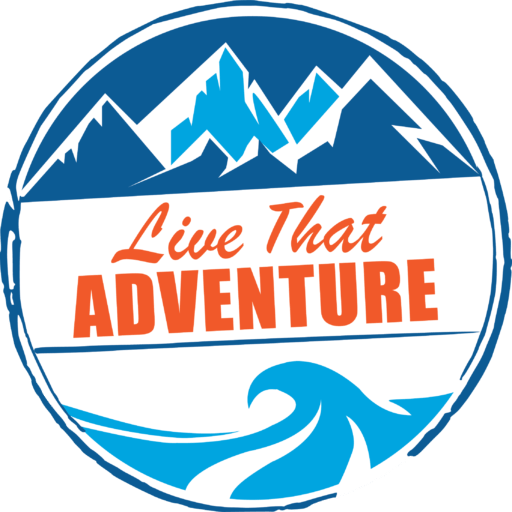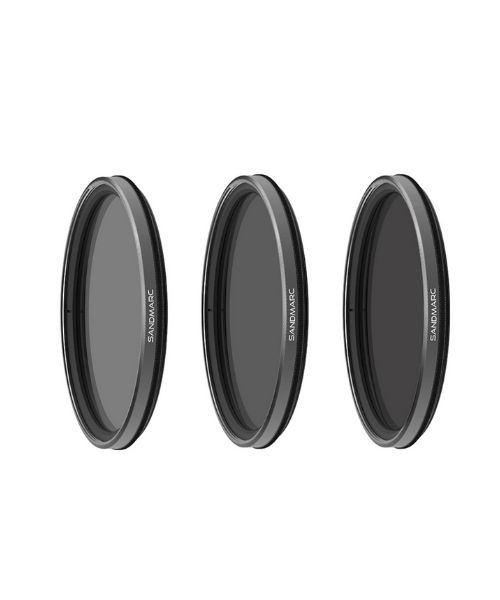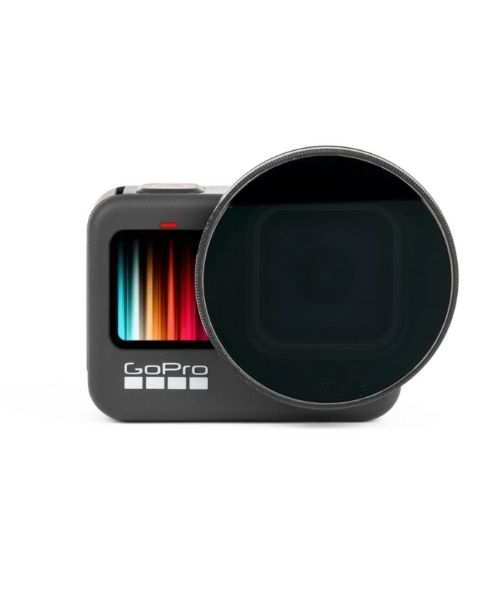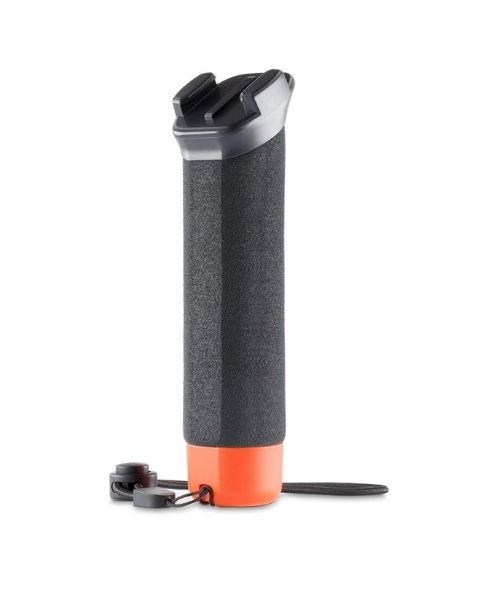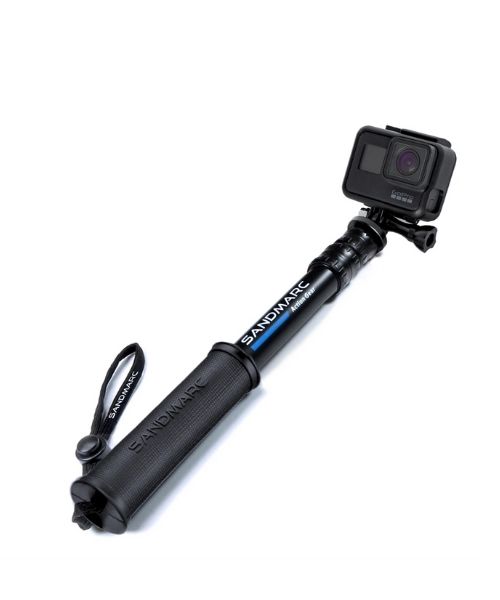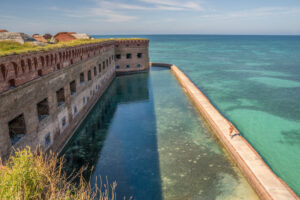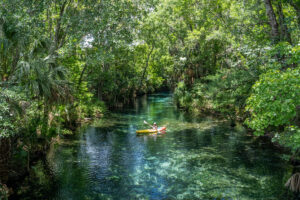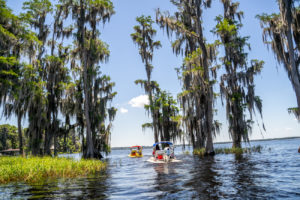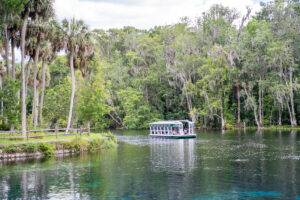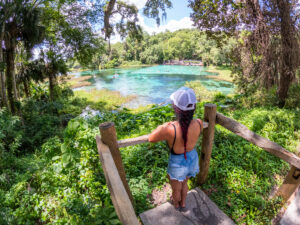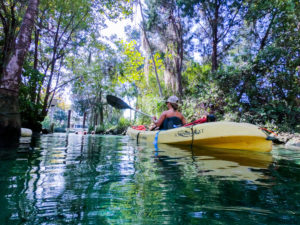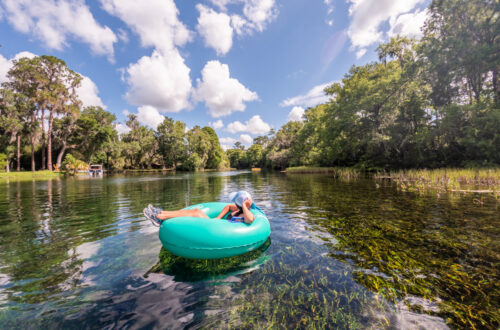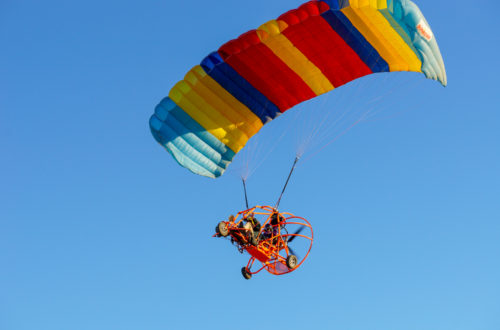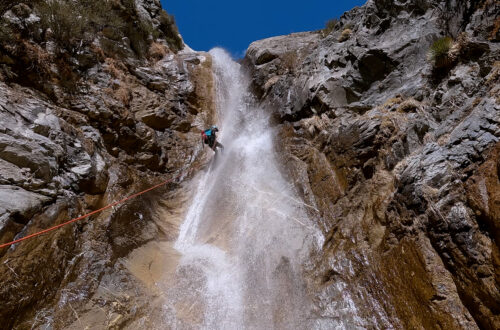Have you ever spent a few nights on a tiny houseboat in the middle of the wilderness? I’m not sure how, but Dustin somehow found out that there is a rental company near Orlando, Florida that would let us stay on a tiny houseboat. He was so giddy about it that we decided to spend our anniversary floating on the St. Johns River on a tiny houseboat. I have to say, it was such a unique adventure, completely different than what we would normally do. Not only that you can stay on it, but you can also drive these adorable vintage tiny houseboats and explore the St. Johns River. It was like camping in a camper van, but on the water, in the middle of nowhere, surrounded by gators. If you’re looking for a unique experience near Orlando, Florida, spending a few nights on the tiny houseboat is a must!
Stats
General Info
Where to rent:
Tiny Houseboat Adventures
Departure Point
2999 FL-44 West, DeLand, FL 32720
Coords: 29°00’38.5″N 81°23’07.9″W
Parking
There is free paved parking in the marina where you can park overnight.
Pet-friendly
No dog allowed on board
Weather
Video
About Tiny Houseboat Adventures
Carrie & Rick started Tiny Houseboat Adventures in 2017 because they want to provide an affordable getaway for people who wanted to spend time in nature. They rent these adorable vintage 1960s houseboats that you can drive to explore along the St. Johns River. These tiny houseboats make for a perfect getaway from touristy Orlando and give your the opportunity to be immersed in the fresh air, and the sounds of the wilderness.
To book with Tiny Houseboat Adventures, you can go here and send them a message. They will get back with the info and how to make your deposit. Please be patient with them. They are short-staffed so it could take a few days for them to get back to you.
What You Need to Know
Important Info
Before renting the tiny houseboat, there are a few things you need to know
- Even though driving the houseboat is not that difficult, you’ll need to have some sort of boating experience, as well as some navigational skills. It will make your adventure a lot less stressful. Also, it’ll be really helpful if you have another person to help with either driving or navigating, especially when docking or navigating through tight passages.
- If you’re born on or after January 1st, 1988, you will need to take a boaters safety course. You can take it for free here.
- You must be at least 25 years old to drive the boat.
- Adventuring on a tiny houseboat is a lot like camping but on the water. This means there is no shower on board and you’ll be limited to 10 gallons of water. You’ll also need to prepare to bring food and drink, as well as sheets and pillows ahead of time. Again, this is similar to camping, so make sure to bring food that doesn’t take a lot of effort to cook.
- If you need to shower, you can do so at Hontoon Island State Park.
- There is no gas station on the North side of DeLand Bridge. The closest gas station to where you’ll be picking up your boat is St. John’s Marina South. The other gas stations are Holly Bluff Marina and Hontoon Landing Resort & Marina. Please note that these places close early, at 5 pm.
- Make sure to have some sort of weather radar app on your phone so you can keep an eye on the weather. We used the News 6 app
How Many Days Should I Stay on the Tiny Houseboat?
We recommend staying at least 2 nights. If you’re staying anything less than two nights, you’ll miss out on a lot of cool things to see. For us, 2 nights were good enough for our first time to get our bearings. If we return again, we might do a couple more extra nights.
What Is the Best Time to Do This?
It is Florida, so you pretty much can do this year-round. However, June through mid-October are peak rainy seasons, therefore, you might encounter thunderstorms. This makes it not safe to be out on the water. The summer can also get extra buggy and humid, especially inside the boat. If you want to see the manatees, winter would be the best time to go. You will need to be careful though to not run into them.
What Should I Bring on My Adventure?
- A phone with Google or Apple Maps for navigating
- Ice for cooler. They provide an ice chest if you don’t have one. The general store at the marina sells ice.
- Drinking water and all the food that you will need for the duration of your stay.
- Polarized sunglasses – this will help you see better for any obstructions in the water
- Beach towels
- Clean bed linens and pillows
- Snorkel gear and swimsuits if you’re planning to go to the springs. (This is not required)
- This is not required, but we brought a small speaker with us to play music. It was actually quite nice!
- Bug spray!! It gets really buggy in the evening.
The Adventure
DAY 1
The Check-in Process
Our adventure started at the boat ramp in DeLand, Florida, near the St. John’s River Grille. This is where we checked in for the tiny houseboat. Rick was already there, putting the finishing touches on our tiny houseboat. After greeting us, he handed us some waiver forms for us to go over. This covered how the boat works and what we can and cannot do. Then, we took a tour of the tiny houseboat while Rick showed us how everything in the boat worked as well as where we can go. We have to admit, it was a lot to take in at the time. There were a lot of things to remember. That being said, it wasn’t really that difficult. You’ll also have Rick’s phone number, so you can always text him if you have any questions.
Once Rick was done going over everything, he followed us out for a test drive. During this time, he showed us how to turn, brake, and finally dock. Happy with how we handled the boat, Rick bid us farewell and sent us on our way. He also told us that he will be in touch to make sure we were doing okay. All the tiny houseboats have tracking devices so that they know where we are at all times. This is for safety purposes, as well as to help guide us to some beautiful sections. Since we will be driving and camping through the remote areas of the St. Johns River and the Lake Woodruff Wildlife Refuge, it was reassuring to know that we’ll always have help if something happened.
The Inside of the Tiny Houseboat
Before we headed out, we got to look around the cabin, our home for the next few days. It was cozy enough for two people. The table in the back can be turned into a full-size bed. There is also a long bench next to the steering wheel that can be turned into a twin-size bed. The little stove and sink are small and adorable. Underneath the cabinet, you can find a few pots and pans, as well as utensils. Even though there isn’t a shower, there is a marine head for #1 and #2. There are windows with screen doors covering them. This helps to keep the bugs out. Since this is a vintage boat, it is not glamorous by any means. However, it definitely has its own charm. As far as we know, the other boats might have a different layout than the red tiny houseboat that we had.
Off to Blue Springs State Park
What we love about our tiny houseboat adventure is the fact that we can pretty much make up our own itinerary. If we go South, we’ll head toward the Hontoon Island State Park and Blue Springs State Park. The route this way is more open and easier to navigate. If we go North, we’ll head toward the more remote areas of the St. Johns River. This means there will be more narrow passages and will require a lot more navigational skills. Since it was our first time, we decided to go South, just so we can get used to driving this tiny houseboat.
Once you get used to it, the tiny houseboat is quite easy to handle. It helps that the houseboat doesn’t go that fast, only about 7mph. It was very peaceful cruising down the St. Johns River. Since we went on a weekday, there weren’t a lot of boats on the river. Therefore, there weren’t a lot of waves. Using our google maps on our phone, we leisurely found our way to Blue Spring State Park. Right before Blue Spring is the Hontoon Island State Park. Apparently, the Hontoon Island State Park is a cool place to stop for hiking, camping, or to use the shower. We didn’t stop here but went straight to Blue Spring State Park.
Blue Springs State Park
We’ve been to Blue Spring State Park before, but by car. It was a bit different arriving by boat. The area where we could drop anchor is next to the kayak rental area, past the buoys. From here, there is a small trail leading over to the park. There were a ton of black vultures hanging out in this area. Make sure to close all the doors to your tiny houseboat before leaving. Another boater we came across told us that their boat got wrecked before by the vultures looking for food. If you haven’t visited Blue Spring State Park before, there are tons of stuff to do here such as swimming, tube ride, snorkeling, picnicking, or hiking.
During the winter, when the river water is too cold, the manatees usually hang out inside Blue Spring State Park. In the summer, they tend to hang out in the river. Please note that they are protected and in serious danger of going extinct. Therefore, please make sure to drive your boat responsibly to avoid hurting them. We weren’t lucky enough to encounter the manatees on our adventures, maybe you will be. If you do, please give them plenty of space and don’t harass them.
Tunnel of Trees
After a good swim at Blue Spring State Park, we went back to our tiny houseboat for a quick lunch. Suddenly, we got a text from Rick, telling us to check out this place called the “Tunnel of Trees”. It is an old logging canal built in the 1800s and just right around the corner from where we were at. Rick also show us how to get there. After wrapping up our lunch, we excitedly went to check out this old logging canal.
This Tunnel of Trees was aptly named. It is a narrow canal, lined with trees and lush vegetation. The water was so calm that it looked like a giant mirror, reflecting the surrounding scenery. That being said, this part was a bit more challenging for us the navigate. Since it was narrow, we had to make sure the boat was in the middle to avoid all the obstacles such as fallen tree stumps and piles of grass. As we cruised through the beautiful canal, we also noticed that at the base of the trees, there are little pops of bright pink color. At a closer look, they look like small clusters of eggs. Apparently, they are Apple snail’s eggs. Such an interesting thing to see! The tunnel of trees was also where we spotted our first gators of the trip.
To the Campsite
Once we were done checking out the “Tunnel of Trees”, we returned back to the main channel of the St. Johns River and headed north. There were a couple of camping spots that Rick had recommended that we wanted to check out. We also made sure to fill up the gas tank on the way back. Sincere there won’t be any gas stations on the north side of where we picked up the boat, we wanted to make sure that we had enough gas. Please note that all the gas stations on the river either close at 5 pm or 6 pm, so make sure to plan accordingly.
The campsite that we wanted to go to was off the main channel. To get there, we followed the St. Johns River north and turn off into a narrow canal. This is also one of the routes to go to De Leon Springs. When we were almost there, we noticed a giant patch of grass blocking almost the whole canal, making it impassable. Being from California, where there is vegetation, there is land underneath. We had no idea that this grass just floats on the water, without any attachment.
The floating “grass” is a combination of dollar weed, water hyacinth, and lily pads. They often break away from their neighbor and float to a different destination. They also get together to form big patches. This, along with the water level, makes the water conditions here change constantly. According to Rick, these patches of grass could be here now, yet gone later in the evening! We had no idea!
Our First Night
Since our path to our first campsite option was blocked, we decided to turn back to the main channel to find another one. Rick also sent us a few other options. With the tiny houseboat, we had to find a spot where we can park in the middle, without touching anything. The boat can spin 360 degrees while anchored, so we needed it to be clear in all directions. Luckily, we found a spot inside a decent-sized cove, big enough to drop anchor without worrying about bumping into stuff, yet secluded enough away from other boats. It was our own little slice of heaven.
After a yummy dinner, it was starting to get dark. The bugs were swamping all over the deck. We didn’t really notice any bugs early because we were driving, however, since the wind died down as it got dark, these little suckers came out. Luckily, the boat has screen doors and windows. We quickly rushed inside and closed all the doors. Once we turned off the lights, it was pitch black all around. Our first night ended peacefully with the sound of nature, surrounding our tiny houseboat.
DAY 2
In the Morning
When we woke up in the morning, everything was so peaceful and serene that it was hard for us to get out of bed. It was such a memorable experience having breakfast on the deck of our little home, on the water, in the middle of the wilderness. After breakfast, we were ready for our second day of adventure.
This time, we wanted to traverse north, through the narrow canals toward De Leon Springs. Since our original route was blocked by the floating grass, we had to figure out another route. Luckily, Rick sent us directions for another route to get there. With that, we pulled anchor and headed out.
To De Leon Springs Part 1
The way to De Leon Springs is a lot trickier to navigate than to Blue Spring State Park. To get there, we followed the St. Johns River to the north, then into Cross Creek toward Hitchens Creek to Lake Woodruff. After crossing Lake Woodruff, we then followed a small canal that leads to Spring Garden Lake, and finally to De Leon Springs. This route took us through the remote area of Lake Woodruff National Wildlife Refuge. Lake Woodruff National Wildlife Refuge is only accessible by boat.
The reason this route is harder to navigate is that there are a lot of turns and narrow canals. You also need to know which passage to go through to avoid the shallow or blocked areas. Fortunately, Rick sent us a detailed route of where to go. As long as we followed closely to his directions, we were fine. It was really reassuring to know that he was making sure that we were safe and enjoying our time. Please note that the water condition changes constantly, so this route might not be available when you go.
To De Leon Springs Part 2
When we were crossing over Lake Woodruff, it was quite interesting. Lake Woodruff isn’t that big compared to Lake George, however, it was big enough for our little watercraft. This was the first time we went through wide-open water on the tiny houseboat. It got a bit choppy as we got closer to the middle of the lake but our little boat handled quite well. Although, at 7mph full speed, it felt like an eternity crossing this lake.
The trickiest section on this route is when crossing over Spring Garden Lake. The lake is quite shallow most of the time. To cross over this lake to De Leon Springs, we have to follow a particular path using the satellite map on our phone. With this map, we followed the deepest part of the lake to cross over. This ensured our boat didn’t get stuck. I have to admit, it was a bit difficult if you’re the only one driving. It helps if there are two of you. For this, I had to watch our GPS on the satellite map the entire time as I guided Dustin through this section. If you ended up going to the shallow area, you’ll be charged your deposit fee, by the way.
De Leon Springs
Once we crossed over Spring Garden Lake, we were just a short distance to De Leon Springs State Park. After docking our boat, we went over to check out the springs. It was a pretty neat place to see. Besides the swimming hole, this place also has a lot of interesting historical landmarks such as the Fountain of Youth and the Old Sugar Mills now turned into a restaurant. If you’re up for it, you can also go hiking, take a boat tour or rent a kayak. It was very hot and humid that day so we opted to spend most of our time at the swimming hole.
Getting Back
After getting our fill of the cool spring water, we headed back to our boat. As we were about to get back on the boat, we spotted a gator, swimming leisurely toward our boat. We named him Al. This was our 5th gator of the trip. Surprisingly, we didn’t see as many as we thought. It doesn’t help that the water here is super murky.
It’s funny because at first, we thought that the water is polluted since it was so dark. However, we found out that the reason the water along the St. Johns River is this color is because of the tannic acid that leaches out of the dried leaves that fall into the swamps and streams that flow into the river. This is why the St. Johns River is called a black-water river. It is also the longest river in Florida and one of the few rivers that run North in the United States. This is because its headwaters are 27 feet higher in elevation than its endpoint. This means that the river drops only 1 inch per mile throughout the 310 mile north, which makes it a “lazy” river.
To the Campsite
Distracted by our gator friend, we didn’t realize that it was getting later. In the forecast, the thunderstorms were supposed to come by in the evening. So, we waved goodbyes to Mr. Al and followed the same route back to the main channel of the St. Johns River. As tricky as the navigation was, it was very peaceful sitting up front and enjoying the cooling breeze as we made our way back. The wind had died down so except for the big lakes, the whole way back was glassy. It was so beautiful, gliding through the mirror-like passages.
Once we were back on the main channel, we found a different spot to drop our anchor. It was also as secluded as the first campsite. We also spotted a resident gator, patrolling back and forth not too far from our boat. We named this one Gary. Gary hung out with us as we had our dinner and then disappeared into the bushes quickly after.
Our Second Night
Since there was a forecast of heavy rains and thunderstorms, we closed all the doors and stayed inside. Sure enough, we could see flashes of lightning lighting up the sky as the heavy rain pelted the top of the boat. The lightning was far enough to be enjoyable but not dangerous. However, it was definitely a super neat way to spend our last night on the tiny houseboat. Both of us drifted to sleep listening to the sound of rain, blending harmoniously with the sound of bullfrogs and other night creatures.
Last Morning
Since we needed to drop off our boat at 10 am, we got up early to enjoy a quick breakfast and the peaceful scenery one last time. Everything was perfectly stilled, a calm after the big storm. The water was so glassy, that it reflected off the cloudy sky above. It was so serene that we wished we could stay another day. Unfortunately, it was time to leave. We stopped at the St. John’s Marina South to fill the gas tank before dropping off the boat. St. John’s Marina South is the closest gas station to where you’ll be dropping off your boat.
Our adventure with Tiny Houseboat Adventures was incredible! It was different than what we usually do but it was something that we didn’t know we needed. It was a combination of eventful and peaceful at the same time! We can’t wait to go back for more adventures. If you’re looking for something unique to do near Orlando, we 100% recommended this! Some other cool things you can do near Orlando are the Wekiwa Springs State Park, going for a Catboat Ride or an Airboat Ride, kayaking in bioluminescence water, or swimming with the manatees in Crystal River.
These are the gear that we personally use and find them helpful for this particular adventure. Don’t forget to check out our Recommended Gear section as well.
camera gear
Related Posts
Save your pins:
